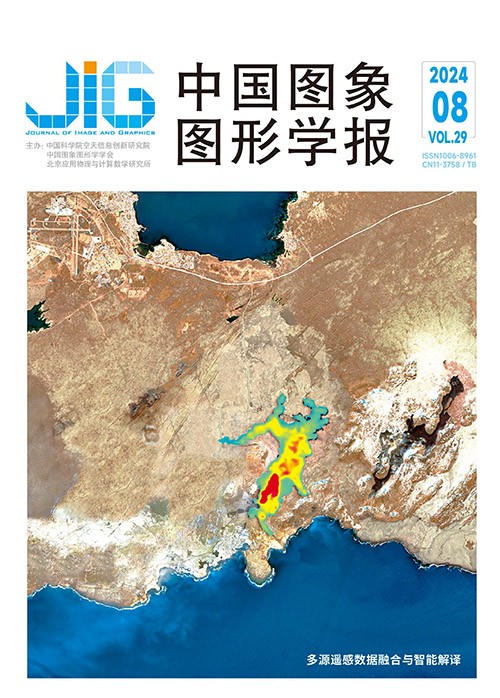
t-SNE最大化的自适应彩色图像灰度化方法
摘 要
目的 彩色图像的灰度化是计算机视觉领域的研究热点。针对传统彩色图像灰度化方法得到的灰度图像存在对比度保持不足、细节模糊及层次感欠缺等问题,本文结合t分布随机邻域嵌入(t-distributed stochastic neighbor embedding,t-SNE)提出了一种更加简单、高效的彩色图像灰度化新方法。方法 首先,将t-SNE降维思想引入到彩色图像的灰度化过程中,设计了一种基于t-SNE最大化的彩色图像灰度化新模型,通过最大化能量函数使原始彩色图像中对比度较小的区域在灰度化后其对比度能够适当地变大或保持,让灰度图像更好地保持原始彩色图像的对比度特征和层次感。其次,在新模型中设计了一种自适应的对比度保持策略,根据颜色对比度信息来自适应地调节原始彩色图像不同区域的灰度化力度,更好地保留原始彩色图像的细节和对比度信息。最后,采用了一种高效的离散搜索方法以快速求解所提新模型。结果 基于Cadik、CSDD(complex scene decolorization dataset)和Color250数据集的大量实验结果表明,与传统方法相比,本文方法得到的灰度图像具有更好的表现,在颜色对比度保持率(color contrast preserving ratio, CCPR)指标上,本文方法在上述3个数据集上的平均CCPR值最高,分别为0.874、0.862和0.864。另外,在相同硬件上测试不同灰度化方法的运行效率时,本文方法的运行时间最短。结论 相较于传统灰度化方法,本文方法不仅能够更好地保持原始彩色图像的对比度、细节特征和层次感,而且在主观评价和客观评价方面均有更好的表现。
关键词
Adaptive decolorization method based on t-SNE maximization
Xie Bin, Xu Yan, Wang Guanchao, Yang Shumin, Li Yanwei(College of Information Engineering, Jiangxi University of Science and Technology, Ganzhou 341000, China) Abstract
Objective Image decolorization converts a color image into a grayscale one. It aims to maintain important features of the original color image as much as possible. It is normally used in the preprocessing stage of pattern recognition and image processing systems, such as extracting fingerprint features, face recognition, and medical imaging. Given that image decolorization maps color images in three dimensions into grayscale images in one dimension, it is a dimensionality reduction process essentially. Thus, the loss of information is inevitable. Accordingly, the major task for researchers can be expressed as preserving important features such as contrast, detail information, and hierarchy of the original color image as much as possible. In the process of acquiring grayscale images, the most basic method is to extract the luminance channel of color images directly. However, acquiring only the luminance information tends to lose the contrast details and appearance features of the input image. In recent years, researchers have focused more on whether grayscale images match the perception of color of the human visual system, and many classical image decolorization algorithms have been proposed. These color-to-gray conversion methods generally fall into two main categories: local mapping methods and global mapping methods. In the local mapping method, the mapping function is spatially varying, that is, the mapping functions of pixels at different spatial locations often differ. The grayscale image obtained by the local mapping method can keep part of the image structure information and local contrast information. However, such methods tend to lose the overall information of the image. They can also produce certain phenomena such as halo and noise enhancement. Some researchers have proposed the global mapping method to address the shortcomings of the abovementioned methods. In the global mapping method, the same mapping function is used for the entire image, and the grayscale value is only related to the color of the original color image. However, many of these methods focus excessively on pixels with large amplitude values, which tend to produce visual overfitting and cause difficulty in retaining information in areas with small contrast. A novel image decolorization method is proposed, in combination with t-distributed stochastic neighbor embedding (t-SNE), to address the problems of insufficient contrast maintenance, blurred details, and lack of hierarchy in grayscale images obtained by the traditional color-to-gray conversion method. This method is simpler and more efficient. Method In this study, considering that t-SNE can better preserve the important features and intrinsic connections of the original high-dimensional spatial data points, we introduce the idea of t-SNE dimensionality reduction into the process of color-to-gray conversion. A new model of color image grayscale is also designed based on t-SNE maximization. In this model, the similarity between any pixel in the original color image is represented by the joint Gaussian probability, while the similarity between any pixel in the corresponding grayscale image is represented by the joint Gaussian probability. The energy function is maximized such that the contrast areas of the original color image with less contrast can be appropriately enlarged or maintained after grayscale. Accordingly, the grayscale image can better maintain the contrast characteristics and the sense of hierarchy of the original color image. In addition, an adaptive contrast retention strategy is designed in this study and introduced into the new model to better preserve the details and contrast information of the original color image. The strategy defines a contrast retention coefficient that can adaptively adjust the graying intensity of different regions of the original color image based on the color contrast information. Given that the proposed maximization model is highly nonlinear, the solution using traditional methods such as gradient descent and iterative method will be particularly complex and time consuming. For this reason, we adopt an efficient discrete search strategy to solve the model. It transforms the continuous parameter optimization problem into a discrete parameter space search to quickly obtain grayscale images, which greatly improves the overall efficiency of the model. Result To demonstrate the effectiveness of the proposed method, we conducted an experimental comparison with various other traditional color-to-gray conversion methods on three different types of datasets, namely, Cadik, complex scene decolorization dataset (CSDD), and Color250. Experimental results show that the proposed method can better maintain the contrast, detail features, and hierarchy of the original color image. For the color contrast preserving ratio (CCPR) metric, the average CCPR values of the proposed method are 0.874, 0.862, and 0.864 for the three datasets when the contrast threshold values range from 1 to 15, respectively, which are better than the average CCPR values of the conventional grayscale method. Comparing the efficiency of different grayscale methods on the same hardware shows that the method has the shortest running time when inputting a raw color image of size 396 × 386 pixels, which is real-time speed. In addition, volunteers were randomly invited to complete preference experiments and accuracy experiments to more comprehensively evaluate the visual effects of grayscale images obtained by different grayscale methods. The experiments showed that the volunteers preferred the grayscale images obtained by the proposed method in this study. Therefore, the proposed method in this study was more consistent with the visual perception of human eyes. Conclusion In this study, we analyze the problems of traditional color-to-gray conversion methods and propose an adaptive decolorization method based on t-SNE maximization. The experimental data based on three datasets show that the proposed method in this study not only maintains the contrast, detail characteristics, and hierarchy of the original color image better but also has better performance in subjective and objective evaluations.
Keywords
color-to-gray conversion t-distributed stochastic neighbor embedding (t-SNE) contrast preserving discrete search detail preserving
|



 中国图象图形学报 │ 京ICP备05080539号-4 │ 本系统由
中国图象图形学报 │ 京ICP备05080539号-4 │ 本系统由